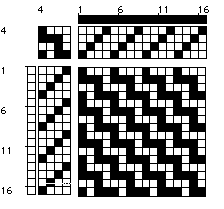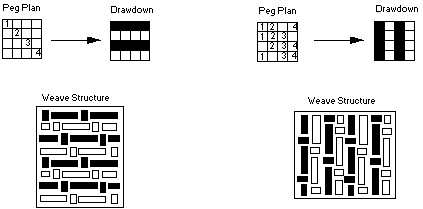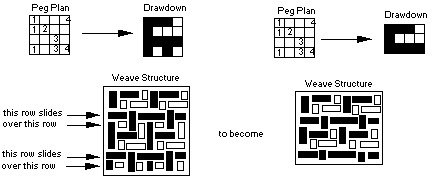
Appendix D. The Problem of Drawdowns for Double Weave.
In bound weave where the warp is widely spaced, weft threads can be beaten so that they hide the warp entirely. They readily slide down to cover the warp. In rep weave the opposite is true. The warp is so dense that the weft, particularly if it is larger in size than the warp, is completely hidden. The warp threads move together hiding the weft. In many of the lace weaves such as huck or Bronson weave structures, the open lace structure results when the warp and/or the weft threads move or slide towards one another. This is most apparent after the cloth has been removed from the loom and the cloth is washed.
In traditional double weave, the warp and weft threads in the top layer are free to move so that they hide the warp and weft threads in the lower cloth layer. This is not apparent if the usual drawdown is made. In addition some of the computer weave programs do not have the capability of showing how this happens. In integrated double weave, all of the warp and weft threads are in a single cloth layer.
Viewing the two sides of a cloth that has some sections in traditional double weave and other sections in integrated double weave seems impossible with any of the computer weave programs available at this time.
1. Traditional Double Weave with Two Cloth Layers.
In double weave where two separate cloth layers are formed, there are no interlacings of the threads between the two layers. The problem is that a drawdown made in the usual manner shows all the threads of the two layers at the same time. The result gives a very misleading picture as shown in the next diagram. The diagram is for a 4-shaft loom, the warp is black and the weft is white, and the tieup and treadling are shown on the left.
Figure 1, Drawdown for Double Weave

It is helpful to look at the drawdown and the weave structure for the first form of double weave. They both show small white squares underneath a field of black threads.
Figure 2. Peg Plan, Drawdown and Weave Structure

If you look at this diagram for a few minutes, you can convince yourself that the threads in the top layer, black, do not interlace with the threads of the bottom layer, white. Because of this the black threads are free to move together, hiding the white threads. Consequently a much better view of the weaving shows only the black threads of the top layer in a slightly expanded form to correspond to the previous diagram.
Figure 3. Weave Structure Revised

The two cloth layers appear clearly in this perspective view.
Figure 4. The Two Cloth Layers of Double Weave

The same set of diagrams for the other basic peg plan for double weave leads to the white cloth layer on the top and the black in the bottom.
Figure 5. The Development to Show the Lower Layer of Double Weave

The drawdown with white spots on a black background translates to two cloth layers, black over white, and the drawdown with black spots on a white background is also recognized as two cloth layers, white over black.
Figure 6. A Shortcut View of Double Weave

II. Integrated Double Weave
If the two basic peg plans for double weave are compared, there are certain things in common. Both have pegs in the four positions along the diagonal from upper left to lower right. Moreover there are no pegs in the four positions shown as zeros.
Figure 7. Common Features of the Basic Peg Plans for Double Weave

There are eight squares in the grid that may or may not have a peg which leads to 256 different peg plans that make up the family of double weave peg plans. Two of these correspond to the peg plans of traditional double weave, that have just been discussed, where two cloth layers are formed. The other 254 peg plans give rise to single layer weaves in what I think of as integrated double weave. Once again drawdown problems arise. Letís look at a few examples to understand why this is true. The first example corresponds to no additional pegs in the diagram immediately above and the second example fills the empty squares with 8 pegs. The peg plan, drawdown and weave structure are shown for each example. It is easy to see from the weave structures that the warp and weft threads are interlocked and will not move past one another. The pattern for the first example is alternating dark and light horizontal lines. The pattern for the second is alternating dark and light vertical lines.
When you look at the back of these weavings, the patterns are interchanged. Horizontal lines on the front become vertical lines on the back and vertical lines on the front become horizontal lines on the back. Any peg plan for the front of a cloth becomes its complementary peg plan when viewed from the back. (The direction of the threading reverses when viewed from the back and designs may be shifted horizontally by several threads.)
Figure 8. Two Examples of Integrated Double Weave

In about half of the 254 peg plans, the result is similar to these two examples. By that I mean that the threads are interlocked as shown and do not move over one another. However, in many of the 254 peg plans, this is not true. Another example will help you see what is happening.
The drawdown numbered 5-24 from Appendix A serves as the example. The peg plan, drawdown and weave structure help to see what happens. Careful examination of the first weave structure on the left reveals that movement of rows 3 and 7 can occur, covering rows 4 and 8. The appearance of the drawdown and of the weave structure when viewed from above changes.
Figure 9. How Some Threads in Integrated Double Weave Become Hidden


Perhaps the easiest way to cope with these complications is through weaving samples. (How many times have you been told this?). Some threads are smooth enough to change their positions readily. Fuzzy threads may not move at all. In any event good luck.